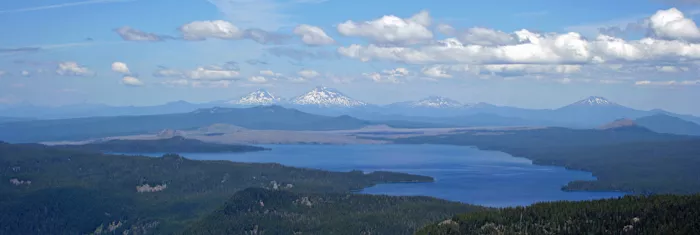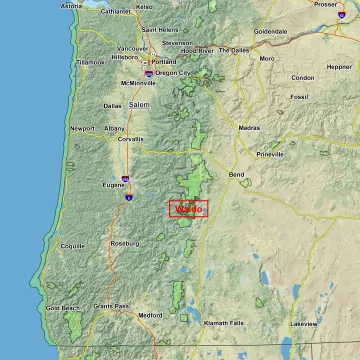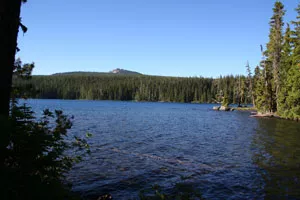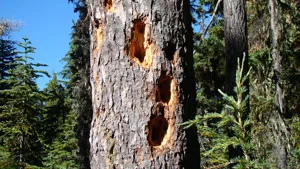Waldo the Beautiful!
As the second largest natural lake in Oregon, Waldo Lake is one of the purest bodies of water in the world, whose water, it has been said, is more pure than laboratory-grade distilled water. This amazing purity stems from the fact that two-thirds of the lake’s water is direct precipitation, with the remaining third from snowmelt and subsurface water flowing from old growth Mountain Hemlock forest sloping up to the Cascade crest. Until 1969 Waldo Lake was entirely primitive, accessed only by a single rough dirt road from Little Cultus Lake some 13 miles to the northeast. At that time Waldo was surrounded by over 250,000 acres of roadless old growth forest, home to threatened species such as Spotted Owls, Pine Martins, Pacific Fisher, and possibly Wolverine. Human use of the area was very light due to the difficulty in getting there, with just a few primitive trails penetrating the surrounding forests.


But, Where's Waldo?
Waldo Lake is on the west side of the Cascade Crest about 10 miles north of Highway 58. The Waldo access road turns off of Hwy 58 to the north about 5 miles west of the Willamette Pass Ski Area.
A Little History
In 1969 the Forest Service built a paved road into Waldo Lake from Highway 58 to the south, and developed three campgrounds with boat launches, toilets, water spigots, and improved campsites on the eastern shore of the lake. Later, a gravel road was built from the Cascade Lakes Highway to the northeast corner of the lake. As a result, the once unbroken wilderness was now bisected from the south and east, and the amount of human access has increased exponentially. Roadless areas outside the designated Three Sisters and Waldo Wilderness Areas are managed by the Forest Service as primitive areas with no motorized vehicle access through administrative rulings, however, these rules can be modified at any time. Currently, automobile and snowmobile access is allowed on the developed roadways; mountain bikes, equestrians, ultra-marathon runners, hikers, cross-country skiers, and snowshoe-ers use the trails through the roadless and old growth areas.
A Roadless Old Growth and Wildlife Haven

The area is administered by the Deschutes and Willamette National Forests, with roughly half of the land area in the Deschutes National Forest and half in the Willamette. From a landscape perspective, this area represents a "missing link" of unprotected land on the Cascade crest and is a critical core habitat for deep forest dwellers such as Pileated Woodpeckers, Spotted Owls, Sooty and Ruffed Grouse, and the mid-sized carnivores mentioned above. Likewise, the Pacific Fisher is considered “rare and possibly declining” in the Deschutes National Forest, but the Forest Service has no management plan for them.
This area is also a possible migration corridor for Wolverines which have recently been photographed in camera traps on Mt. Adams in Washington, and to the south in the Sierra Nevada in California. Wolverines have shown up sporadically in the Oregon Cascades over the years, but no resident population is confirmed in Oregon. They are listed as threatened by the state but have no federal protection due to political roadblocks and budgetary constraints. Wolverines were considered extinct in California since 1910 until one showed up in a camera trap in 2008. Similarly, they were thought to be extirpated in the Cascades south of Mt. Rainier until one also showed up in a camera trap on the flanks of Mt. Adams in 2006, roughly 40 miles north of the Oregon border.

Clearly, the roadless areas around Waldo Lake are core habitat for deep forest dwellers that do not tolerate noise, sustained human incursions, roads, logging, cars, snowmobiles, ATVs, and other inventions of man. They need undisturbed roadless habitat, plain and simple, and these areas provide it beautifully. In addition to wildlife concerns, this area has the largest old growth Mountain Hemlock stand in the state, beautiful lake basins, mountain meadows, streams, several peaks over 7000 feet, and the quiet solitude that is only found in true wildness. Fourteen miles of the Pacific Crest Trail pass through the area. Current threats to the area are encroaching edge effects from the east and south, logging, ATV and snowmobile use, and increased human pressure.
The Maiden Peak/Waldo Lake roadless area is approximately 100,000 acres in size, is a primitive old growth forest with no roads or other human improvements past trails and a few primitive shelters built in the '30s and '40s. With over 100 lakes, several streams, and countless meadows, it is primarily in the same condition as it was when Lewis and Clark first arrived here in Oregon some 200 years ago. Clearly, the Maiden Peak/Waldo Lake roadless area needs to be protected in perpetuity.
Watch our new Keep Waldo Wild video taken at our 2016 summer campout. If you're still not convinced that the Waldo Lake area is one of the Gems of Oregon, take a look. For the full screen impact, click the Full Screen Square in lower right hand corner.
And thank you, Matty Sturtevant, chief videographer and editor! Enjoy.
